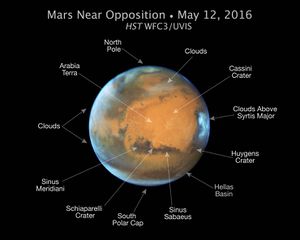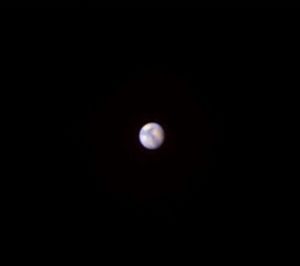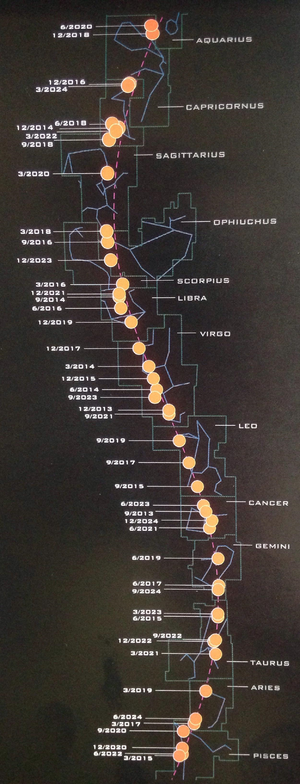Difference between revisions of "Observing Mars with a Telescope"
| Line 7: | Line 7: | ||
[[File:MarsInZodiac.png|thumb|left|Chart depicting the progression of Mars through the zodiac constellations at three-month intervals over a period of 10 years. Gaps in the sequence indicate when Mars is too close to the Sun to be seen.]] | [[File:MarsInZodiac.png|thumb|left|Chart depicting the progression of Mars through the zodiac constellations at three-month intervals over a period of 10 years. Gaps in the sequence indicate when Mars is too close to the Sun to be seen.]] | ||
[[File:OppositionConjunction.jpg|thumb|right|Diagram illustrating the relative positions of Earth and Mars at opposition and conjunction. The two planets reach opposition roughly once every 26 months.]] | [[File:OppositionConjunction.jpg|thumb|right|Diagram illustrating the relative positions of Earth and Mars at opposition and conjunction. The two planets reach opposition roughly once every 26 months.]] | ||
| − | Timing plays an essential role in viewing Mars from Earth. The differing orbits between the two planets mean that Mars enters opposition—that is, the point where it and Earth are on the same side of the Sun and therefore at their closest approach—once every 26 months.<ref name=":0" /><ref>Sparrow, G. (2013). ''Constellations: A Field Guide to the Night Sky'' (First). Quercus.</ref> For the majority of the year, Mars appears fairly small in the sky, although not so small that it is invisible to the naked eye. During a window of several months before and after opposition, however, it appears brighter and large enough to make out surface features with the help of a telescope.<ref name=":0" /> <references /> | + | Timing plays an essential role in viewing Mars from Earth. The differing orbits between the two planets mean that Mars enters opposition—that is, the point where it and Earth are on the same side of the Sun and therefore at their closest approach—once every 26 months.<ref name=":0" /><ref name=":1">Sparrow, G. (2013). ''Constellations: A Field Guide to the Night Sky'' (First). Quercus.</ref> For the majority of the year, Mars appears fairly small in the sky, although not so small that it is invisible to the naked eye. During a window of several months before and after opposition, however, it appears brighter and large enough to make out surface features with the help of a telescope.<ref name=":0" /> |
| + | |||
| + | The ease with which these surface features can be observed varies from one opposition to another. The orbit of Mars around the Sun is elliptical in nature, and the timing of Earth’s closest approach does not always occur at the same point along this ellipse. If opposition happens to coincide with Mars’ closest approach to the Sun (perihelion), substantially less distance separates the two planets than if they near one another when Mars is farthest from the Sun (aphelion). Depending on the timing of opposition, then, this distance can range between 34 and 71 million miles (55-100 million kilometers).<ref name=":1" /><ref>Ventrudo, B. (2018, June 28). Agena AstroProducts Observing Guide: The Planet Mars. Retrieved September 15, 2019, from Agena Astro website: <nowiki>https://agenaastro.com/articles/mars-observing-guide.html</nowiki></ref> | ||
| + | |||
| + | Naturally, such a large variation in distance has a profound effect on the visibility of Mars from our planet. This visibility can be described both in terms of apparent size—measured in degrees, arcminutes, and arcseconds—and brightness, measured by an inverse logarithmic scale known as “apparent magnitude.” The brighter an object appears in the sky, the lower its magnitude, with 1 point of magnitude representing a difference in brightness of 2.5 times.<ref name=":1" /> The brightest celestial objects have negative magnitudes, and the unaided human eye can perceive magnitudes up to about 6.0.<ref name=":1" /> | ||
| + | |||
| + | The apparent size of Mars can be as small as 3.5 arcseconds when farthest away (as a point of comparison, the Sun and Moon are both 30 arcminutes—1,800 arcseconds—in diameter, while Jupiter can reach 50 arcseconds at closest approach)<ref>Ventrudo, B. (2018, July 13). How to See Mars in 2018 – Cosmic Pursuits. Retrieved September 15, 2019, from Cosmic Pursuits website: <nowiki>https://cosmicpursuits.com/2183/how-to-see-mars-in-2018/</nowiki></ref> [red][green but check citation][gray], but at its closest to Earth this number grows to anywhere between 15 and 25 arcseconds, depending on when opposition occurs. Similarly, the apparent magnitude of Mars can reach +1.6 [yellow[ at its greatest separation from Earth, but at opposition the brightness increases to somewhere between -1.8 and -3.0 [gray] [yellow]. <references /> | ||
Revision as of 10:46, 15 September 2019
volunteer for The Mars Society
It is licensed under Creative Commons BY-SA 3.0 and may be freely shared, but must include this attribution.
Mars constitutes the only planet in the solar system with surface features easily distinguishable from Earth—of the inner planets, Mercury’s small size and proximity to the sun make viewing exceptionally difficult, while Venus’ surface hides behind a thick layer of clouds.[1] As such, Martian surface features have long captured the imagination of astronomers, even helping lead to the longstanding popular belief of its inhabitation by extraterrestrial civilization. In 1877, Italian astronomer Giovanni Schiaparelli began mapping areas on Mars, including long, dark lines he named “channels”, or “canali."[2] Mistranslations of this word to English “canals” along with his own observations encouraged American Percival Lowell to theorize that these dark lines were the work of intelligent beings attempting to irrigate their dying planet.[3] Although these lines were soon after revealed to be an optical illusion resulting from the mind’s attempts to connect dark areas at the extent of its vision,[4] even amateur astronomers can make out a variety of other surface features with the aid of a telescope.
When can Mars be seen?
Timing plays an essential role in viewing Mars from Earth. The differing orbits between the two planets mean that Mars enters opposition—that is, the point where it and Earth are on the same side of the Sun and therefore at their closest approach—once every 26 months.[1][5] For the majority of the year, Mars appears fairly small in the sky, although not so small that it is invisible to the naked eye. During a window of several months before and after opposition, however, it appears brighter and large enough to make out surface features with the help of a telescope.[1]
The ease with which these surface features can be observed varies from one opposition to another. The orbit of Mars around the Sun is elliptical in nature, and the timing of Earth’s closest approach does not always occur at the same point along this ellipse. If opposition happens to coincide with Mars’ closest approach to the Sun (perihelion), substantially less distance separates the two planets than if they near one another when Mars is farthest from the Sun (aphelion). Depending on the timing of opposition, then, this distance can range between 34 and 71 million miles (55-100 million kilometers).[5][6]
Naturally, such a large variation in distance has a profound effect on the visibility of Mars from our planet. This visibility can be described both in terms of apparent size—measured in degrees, arcminutes, and arcseconds—and brightness, measured by an inverse logarithmic scale known as “apparent magnitude.” The brighter an object appears in the sky, the lower its magnitude, with 1 point of magnitude representing a difference in brightness of 2.5 times.[5] The brightest celestial objects have negative magnitudes, and the unaided human eye can perceive magnitudes up to about 6.0.[5]
The apparent size of Mars can be as small as 3.5 arcseconds when farthest away (as a point of comparison, the Sun and Moon are both 30 arcminutes—1,800 arcseconds—in diameter, while Jupiter can reach 50 arcseconds at closest approach)[7] [red][green but check citation][gray], but at its closest to Earth this number grows to anywhere between 15 and 25 arcseconds, depending on when opposition occurs. Similarly, the apparent magnitude of Mars can reach +1.6 [yellow[ at its greatest separation from Earth, but at opposition the brightness increases to somewhere between -1.8 and -3.0 [gray] [yellow].
- ↑ 1.0 1.1 1.2 Landers, Z. (2019, June 15). Viewing Mars With Your Telescope—Extensive Guide. Retrieved September 15, 2019, from Telescopic Watch website: https://telescopicwatch.com/viewing-mars-with-telescope/
- ↑ Canright, S. (2009, April 13). NASA - The “Canali” and the First Martians [Learning Materials]. Retrieved September 15, 2019, from NASA website: https://www.nasa.gov/audience/forstudents/postsecondary/features/F_Canali_and_First_Martians.html
- ↑ Milner, R. (2011, October 6). Tracing the Canals of Mars: An Astronomer’s Obsession. Retrieved September 15, 2019, from Space.com website: https://www.space.com/13197-mars-canals-water-history-lowell.html
- ↑ Evans, J. E., & Maunder, E. W. (1903). Experiments as to the actuality of the" Canals" observed on Mars. Monthly Notices of the Royal Astronomical Society, 63, 488-499.
- ↑ 5.0 5.1 5.2 5.3 Sparrow, G. (2013). Constellations: A Field Guide to the Night Sky (First). Quercus.
- ↑ Ventrudo, B. (2018, June 28). Agena AstroProducts Observing Guide: The Planet Mars. Retrieved September 15, 2019, from Agena Astro website: https://agenaastro.com/articles/mars-observing-guide.html
- ↑ Ventrudo, B. (2018, July 13). How to See Mars in 2018 – Cosmic Pursuits. Retrieved September 15, 2019, from Cosmic Pursuits website: https://cosmicpursuits.com/2183/how-to-see-mars-in-2018/











